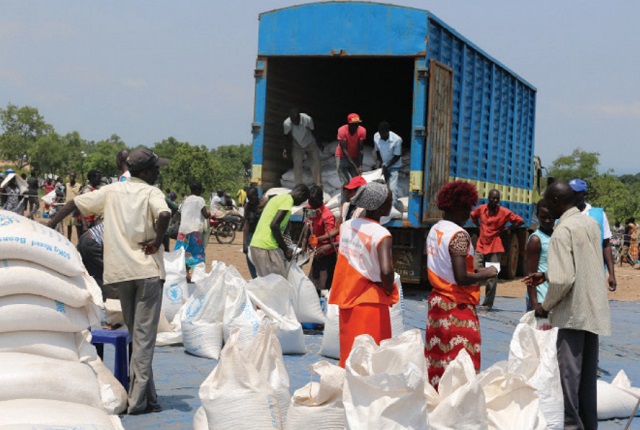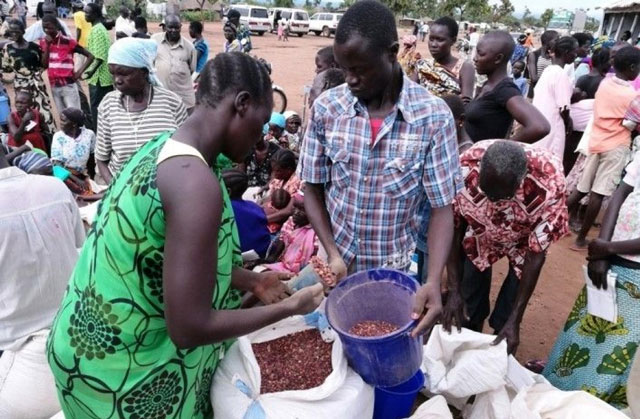
Kampala, Uganda | THE INDEPENDENT | Starting November 2021, more than 530,000 refugees in certain settlements in northwestern Uganda will receive food rations of 70% from the United Nations World Food Programme (WFP). This is up from the current 60 % ration they and all other refugees have been receiving since February 2021.
According to joint vulnerability assessments conducted in 2019 and 2020 by WFP, the Office of the Prime Minister (OPM), and UNHCR, the refugees living in Bidibidi, Imvepi, Lobule, Palorinya and Rhino settlements are categorized as the most vulnerable group due to the very large proportion of people living here that are unable to meet their basic food needs.
The vulnerability assessment also indicated that generally the level of vulnerability is higher in settlements in the Northwest of Uganda than the Southwest.
To provide full rations to all registered refugees in Uganda living in settlements, WFP requires over $220 million in funding per year. At present, even with ration adjustments, WFP has a shortfall of $57 million for the next six months general food assistance in settlements.
Less food secure regions
In this resource prioritisation exercise, WFP had to also revise food rations of settlements whose communities are slightly less food secure than those in the Northwest. Kyaka II, Kyangwali, Nakivale, Oruchinga and Rwamwanja settlements in southwestern Uganda have lower vulnerability levels, because of the region’s better livelihood options and lower prices of food and other essentials. Starting November, these settlements will receive a 40 percent ration, down from the current 60 percent.
Three settlements in the North – Adjumani, Kiryandongo, and Palabek – have been assessed to be somewhat less vulnerable than the settlements in the Northwest and will continue receiving a 60 percent ration. While the prioritization focuses on relative vulnerability, it is important to note that absolute levels of vulnerability are very high in all setlements.
The vulnerability assessment further indicates that thanks to more reliable rainfall and fertile soil in the Southwest, settlements there offer refugees a greater potential for becoming self-reliant.
In addition, with food prices lower, the 40 percent ration they will receive in cash assistance can buy nearly the equivalent 60 percent ration that refugees residing in settlements in the North receive as in-kind food assistance.
“Over the last two years, declining funding has forced WFP to cut rations. These ration cuts have, in the past, been done uniformly for all refugees. The result is that they affect the poorest and most vulnerable refugees the most. To reduce the disproportionate impact of ration cuts, we have embarked on a prioritisation exercise that will enable us to allocate the limited resources we have in support of refugee communities that need it the most. We are increasing the rations of the poorest settlements that have been hardest hit by earlier ration cuts. Unfortunately this means that we have to reduce rations for refugees who have greater potential for self-reliance,” WFP Country Director Abdirahman Meygag said.
He described prioritisation as a difficult but necessary decision, adding, “It is not by choice that we are cutting rations for some refugees. The available resources do not allow us to sustain the same level of assistance for everyone. Declining funding means we have to make difficult decisions so that we do not unfairly disadvantage those who need support the most.”
Rations down by 70% in 2020
The last time WFP was able to provide a full ration to refugees was in early 2020. In April 2020, rations had to be reduced to 70 percent. Further cuts came in February 2021 when the ration went down to 60 percent.
“Despite a difficult resource terrain, WFP has shown commitment to supporting the refugee response. We call upon more donors to support Uganda’s refugee response so that we can effectively respond to the increasing number of refugees,” said Minister of State for Relief, Disaster Preparedness and Refugees, Esther Anyakun Davinia.
“As government, we are proud to receive refugees, support and lead them to self-reliance. However, they can only move to self-reliance if we support them at a time when they are most vulnerable.”

Uganda, the country with the largest refugee population in Africa, has an open-door policy towards refugees. Refugees receive land to settle on and farm. They can move freely within the country, start businesses and work. Even with the new prioritisation exercise that will see some settlements receive further reduced rations, refugees who have just arrived in the country will receive a full food ration for three months. Thereafter, they will receive the same ration as others in their settlement.
“The news of prioritisation according to needs is difficult to take for refugees who are having their ration cut to 40 percent,” said Leo Asiimwe Mugabe, Assistant Commandant, Rwamwanja Settlement. “However, we understand that even though we also have challenges meeting our food needs, some people are worse off than us. We know that the reduction is necessary so that we can support the most vulnerable refugees. We hope that with time more funding can come in so that all refugees can have their needs met.”
Prioritisation will only affect food assistance (cash and in-kind), while other support provided by WFP, UNHCR and humanitarian partners at large as well as services delivered through government systems will continue, including interventions helping fight malnutrition and enabling refugees to build their livelihoods.
“UNHCR stands in solidarity with refugees during these very difficult times,” said Joel Boutroue, UNHCR Representative to Uganda. “Rest assured that we will leave no stone unturned to find appropriate solutions for the most vulnerable refugees, as we call on development partners to invest in sustainable livelihood programming for refugees and their hosts.”
WFP Uganda’s refugee response is funded by Canada, European Union, Germany, Japan, Republic of Ireland, Republic of Korea, Norway, Sweden, UK and the US. Despite Germany, Japan, Norway and Sweden coming onboard as new or returning donors this year, this support has still not been enough to counter the impact of declining support to the refugee response from other donors.
 The Independent Uganda: You get the Truth we Pay the Price
The Independent Uganda: You get the Truth we Pay the Price



